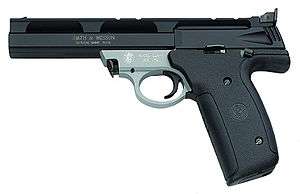Smith & Wesson Model 22A
| Smith & Wesson Model 22A | |
|---|---|
 S&W 22A | |
| Type | Semi-automatic pistol |
| Place of origin | United States |
| Production history | |
| Manufacturer | Smith & Wesson |
| Unit cost | $329[1] |
| Variants |
Standard Issue (SI) Service Grade (SG) Service Grade Commander (SGC) Titanium Edition (TI) Titanium Edition Commander (TIC) |
| Specifications | |
| Weight | 975.2 g (2.150 lb) empty, w/ magazine |
| Length | 24.1 cm (9.5 in) |
| Barrel length | 13.9 cm (5.5 in) |
|
| |
| Cartridge | .22 Long Rifle |
| Action | Blowback operated Semi-automatic |
| Feed system | 10-round detachable box magazine |
| Sights | Partridge front sight, adjustable rear sight |
The Smith & Wesson Model 22A is a semi-automatic pistol that was manufactured in Houlton, Maine. The 22A is a full-size pistol with an aluminum alloy frame. The steel barrel has an integrated Weaver style rail (similar to a Picatinny).
This pistol is distinguished by two features: An integral rail along the top edge of the gun permits easy mounting of optical sights and other accessories. The gun's alloy frame and alloy-shrouded barrel help keep weight down for a full-sized pistol.
Design
The 22A is a hammer-fired, semi-automatic .22 caliber pistol. The enclosed hammer rotates in the frame, hitting the rear of the firing pin in the slide, which then hits the rim of the chambered round. After chambering the first round by pulling back and releasing the slide, each firing ejects the spent cartridge, cocks the hammer, and then strips a new round from the magazine and loads it into the chamber. The hammer is automatically cocked, and pulling the trigger simply releases it. This results in a lower trigger pull force unlike a double-action pistol where the trigger must first cock the hammer and then release it.[2]
A frame mounted safety switch is present along the left side of the frame in the conventional location to be operated by the user's right thumb. Patridge-type target sights are standard on this gun, with the rear sight adjustable for both windage and elevation. The front sight is integral with the barrel shroud and is not removable or adjustable. An integral feed ramp at the barrel breech helps assure reliable loading of rounds into the chamber from the magazine.
Later models incorporate a magazine safety that does not permit the gun to fire unless the magazine is fully seated. This feature helps prevent accidental discharge during careless handling especially during cleaning.
The magazine release is located on the front of the grip making it easy to locate and also makes it ambidextrous as well since it is equally well placed for both right and left handed shooters. This is more of a problem for people with smaller hands where the finger tips may lay on the front of the handle when gripping the gun. Typically ejecting a magazine requires retracting your middle finger and pushing in on the release with the finger tip. The eject button is difficult to depress with the middle part of the finger.[3]
The gun was dropped from the Smith & Wesson catalog in 2015, much to the chagrin of shooters among whom the gun was very popular. S & W has also dropped many other popular and reasonably priced 22's such as the 2213/2214 and 422/622 pistols, while retaining the high priced Model 41.
The gun takes down easily for cleaning via a pushbutton at the front that disengages the barrel from the frame. It is therefore possible to rapidly exchange barrels, for example to switch on and off one with a mounted scope, etc.[2]
There were several variants in terms of available barrel length (4", 51⁄2", 7"), target grips, and frame colors (gray or black). The stainless steel version (as opposed to the blued steel) was called the 22S.[2]
Front grip magazine
While accurate, the front grip magazine release and relatively heavy trigger pull make this pistol more suited to plinking than competitive target shooting.[2] The location of the magazine release causes problems for some people in rapid fire situations,[3] the extent of which depends on hand size and gripping style. For most shooters, the location does not cause a problem. However, in competitive shooting it can add a risk . The trigger pull, while not excessive, is heavier than some of the other target pistols. Accuracy is quite good though, and the pistol's low price made it a good introductory gun for target shooting. It can be quite competitive against much more expensive models.[3]
References
- ↑ Smith & Wesson Product 107412, Model 22A
- 1 2 3 4 Supica, Jim; Nahas, Richard (2007). Standard Catalog of Smith & Wesson. Iola, Wisconsin: F+W Media, Inc. p. 282. ISBN 0-89689-293-X.
- 1 2 3 Michalowski, Kevin (27 October 2004). The Gun Digest Book of Guns for Personal Defense: Arms & Accessories for Self-Defense. Iola, Wisconsin: Gun Digest Books. p. 102. ISBN 0-87349-931-X.